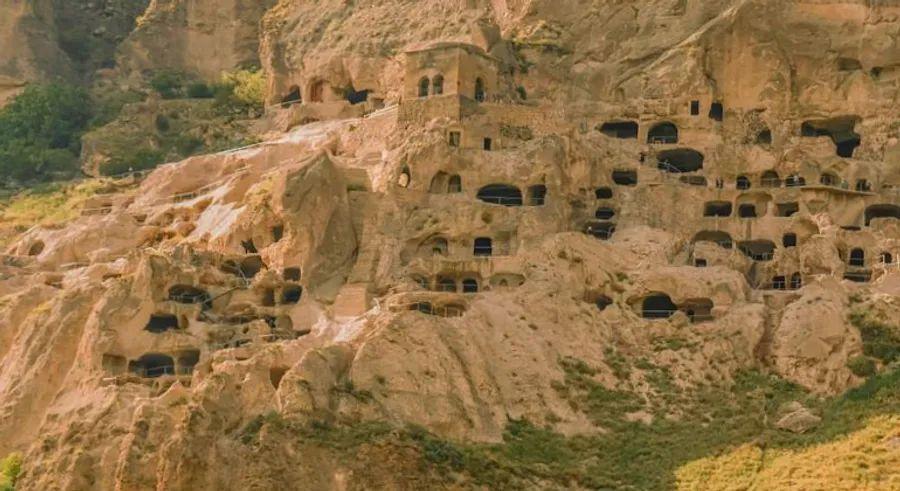Discovering Vardzia: Georgia’s captivating rock-carved cave city

From the ancient Uplistikhe, dating back 3,000 years, to the 6th-century David Gareja Monastery and the forgotten ruins of Samshvilde, Georgia’s cave sites are truly breathtaking.
Yet, none surpass the grandeur of Vardzia.
Perched along the Erusheti slopes, overlooking a verdant valley etched by the Mtkvari River, Vardzia is undoubtedly Georgia’s most exceptional cave city.
In its prime, this rock-hewn fortress was home to 6,000 chambers spread across 19 levels, including 25 wine cellars, a convent, 15 chapels, and an apothecary—together forming a thriving medieval city and monastery.
Hidden escape passages, perplexing dead-ends
Originally built as a fortress in the 12th century during the reign of King Giorgi III, it was his daughter who truly brought the vision to life. Under her leadership, a complex network of caves and chambers was carved deep into the heart of Erusheti, including a concealed escape tunnel and a maze of dead-end corridors designed to disorient invaders.
Over time, it transformed from a simple fortress into a vast monastery, cultural hub, and strategic stronghold. Vardzia housed around 2,000 monks, supported tens of thousands of people, and, thanks to its fertile terraces and advanced irrigation, became a self-sufficient city long before such concepts were commonplace.
At the helm of this grand project was Tamar the Great, a ruler so formidable she was crowned king – Tamar Mepe. Throughout her nearly 30-year reign, she navigated both political and territorial success, expanding Georgia’s influence across the Greater Caucasus and deep into regions now part of modern-day Ganja and Erzurum.

It was a golden era for literature and art, giving rise to some of Georgia's most prominent figures. Among them was Shota Rustaveli, a medieval poet whose unrequited love for Queen Tamar and his epic poem 'The Knight in the Panther’s Skin' earned him a lasting place in history and a street named after him in nearly every Georgian city.
Despite its prosperity, Vardzia’s reign was tragically brief. In 1283, a massive earthquake devastated the region, destroying over 70% of the city and sending the outer wall tumbling down in a catastrophic avalanche. Left vulnerable, the majority of Vardzia's inhabitants fled, leaving only the determined monks behind.
The monastic community persevered for another 300 years before being wiped out by successive raids.
More than 800 years after the reign of King Tamar, a small group of monks has returned to care for Vardzia, resettling there after the fall of the Soviet Union.
Around 500 caves still stand, including an apothecary with its intricately carved shelves intact, and wine cellars where ancient qvevris (wine vessels) are still embedded in the earth, as though time has stood still.
Deeper within the mountain lies a network of untouched tunnels – some stretching over 600 feet – forming an intricate, ancient web that connects the site.

Even the weathered dining hall, with its stone-carved benches and an ancient hearth for baking, endures through the ages.
The most striking feature you’ll encounter is the towering bell tower, rising from a rocky ledge. It still preserves much of its original splendor, though one significant part is missing – the bell, which was taken during a Mongol raid.
The highlight is the Church of the Dormition, with its remarkable double-arched portico and bell, seamlessly carved into the mountain. Inside, you’ll find stunningly aged frescoes, including one of the only four existing depictions of King Tamar.
Visitors should seek out the Tears of Queen Tamar, a hidden spring deep within the tunnels. Here, a pool seems to be weeping, with water flowing from the rocks above, giving the impression of tears.
Beyond Vardzia
The surrounding area has much to offer as well. Directly across from Vardzia lies the Vardzia Cavetown Viewpoint, a perfect spot to take in the entire landscape from a distance.
Then, there’s the lesser-known Vanis Kvabebi (Vani Caves), a stone-carved monastery just a 10-minute drive from Vardzia.
Older than Vardzia by a few centuries, Vanis Kvabebi is nearly as awe-inspiring. Adventurous climbers can ascend the ruins via a series of wooden ladders, leading up to a small white-domed church with panoramic views of the valley below.
Not far from Vanis Kvabebi lies Tmogvi Fortress, perched high above the river. This sprawling ruin features an ancient citadel, faded frescoes, and crumbling towers that tell stories of a bygone era.
On your way back to Tbilisi, you’ll reach a fork in the road, marked by Khertvisi Fortress – a medieval castle stretched out on a rocky promontory. Turning right will lead you toward Armenia and deeper into the region of Samtskhe-Javakheti.

Vardzia is located in Samtskhe-Javakheti, a region in southern Georgia bordered by Turkey and Armenia, rich in culture, diverse landscapes, and flavorful cuisine. In the northern part of the region lies Borjomi, a forested spa town renowned for its healing springs and bottled mineral water that, according to local legend, can cure even the worst hangovers.
Then there’s Akhaltsikhe, a serene town dominated by Rabati Castle, a medieval fortress that symbolizes the region's diversity, complete with a mosque, synagogue, and an Orthodox church.
In the southeast corner of the region, you’ll discover Paravani Lake, the largest in Georgia, surrounded by volcanic mountains and rugged, windswept terrain. On its southern shore lies the village of Poka, home to the St. Nino Nunnery, a humble convent tied to the legend of St. Nino, the woman who introduced Christianity to Georgia, making it the second nation in the world to adopt the faith after Armenia.
The convent also features a small shop run by the nuns, where they craft artisanal chocolates, traditional cheeses, and even beer brewed in qvevri.
The region’s identity is as much defined by its culinary heritage as by its cultural landmarks. Influenced by various civilizations over the centuries, Samtskhe-Javakheti is home to an array of mouthwatering dishes.
Nestled high in the hills above Akhaltsikhe, Andriatsminda is a small village where a handful of local families have kept alive the time-honored tradition of making tenili, a cheese famous for its delicate angel hair texture.
Also thought to be a remnant of French priests’ influence in the area, you’ll come across lokokina (snails), which are served either as a filling for khinkali (dumplings) or plated in the classic escargot style.
Other regional specialties include apokhti khinkali, filled with dried meats like goose, Meskhuri shoti (Meskhetian bread), and the long-time favorite tatarberaki – small squares of boiled dough drenched in a savory sauce made from garlic, onion, butter, and yogurt.
How to get there
A little over four hours from Tbilisi, a scenic drive through the lush forests of Borjomi and the fortress-dotted town of Akhaltsikhe will bring you to Vardzia.
You can either hire one of the many eager drivers waiting at Freedom Square, or opt for a rental car to take the wheel yourself. While it's possible to make a day trip, the area is best experienced over a couple of days to truly take it all in.

1

2

3

4

5
Evaluation :
5/5